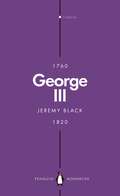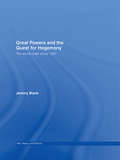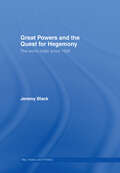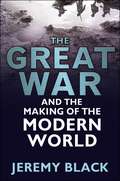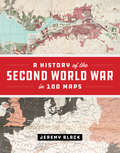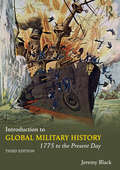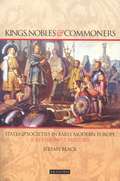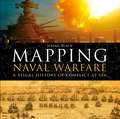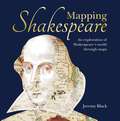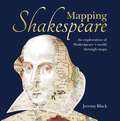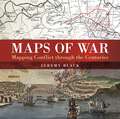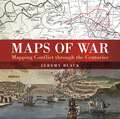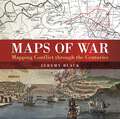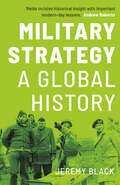- Table View
- List View
George III: Madness and Majesty (Penguin Monarchs)
by Jeremy BlackKing of Britain for sixty years and the last king of what would become the United States, George III inspired both hatred and loyalty and is now best known for two reasons: as a villainous tyrant for America's Founding Fathers, and for his madness, both of which have been portrayed on stage and screen.In this concise and penetrating biography, Jeremy Black turns away from the image-making and back to the archives, and instead locates George's life within his age: as a king who faced the loss of key colonies, rebellion in Ireland, insurrection in London, constitutional crisis in Britain and an existential threat from Revolutionary France as part of modern Britain's longest period of war.Black shows how George III rose to these challenges with fortitude and helped settle parliamentary monarchy as an effective governmental system, eventually becoming the most popular monarch for well over a century. He also shows us a talented and curious individual, committed to music, art, architecture and science, who took the duties of monarchy seriously, from reviewing death penalties to trying to control his often wayward children even as his own mental health failed, and became Britain's longest reigning king.
Great Powers and the Quest for Hegemony: The World Order since 1500
by Jeremy BlackThis timely book provides a general overview of Great Power politics and world order from 1500 to the present. Jeremy Black provides several historical case-studies, each of which throws light on both the power in question and the international system of the period, and how it had developed from the preceding period. The point of departure for this
Great Powers and the Quest for Hegemony: The World Order since 1500 (War, History And Politics Ser.)
by Jeremy BlackThis timely book provides a general overview of Great Power politics and world order from 1500 to the present. Jeremy Black provides several historical case-studies, each of which throws light on both the power in question and the international system of the period, and how it had developed from the preceding period. The point of departure for this
The Great War and the Making of the Modern World
by Jeremy BlackThis new work demonstrates how the outcome of the First World War has formed the modern world we live in today. The First World War was the Great War for its leading participants. In revisiting the events of 1914-1918 a century on, Jeremy Black considers how we now look at the impact of the conflict across the globe and how it came to be World War I in our consciousness. For millions, both soldiers and civilians, the conflict proved fatal. The suffering and loss of the war provides much of its resonance and significance, but this book seeks to throw light beyond this, not least in asking how it ended in victory and defeat. Casting aside the conventional narrative, Jeremy Black returns to a vast range of original sources and investigates not only the key events of the war, but its consequences in restructuring the old order. As its significance has changed with time, and not only with the loss of first-hand testimony, Black considers the struggle not only in its historical context but through its memorialisation today.
The Great War and the Making of the Modern World
by Jeremy BlackThis new work demonstrates how the outcome of the First World War has formed the modern world we live in today. The First World War was the Great War for its leading participants. In revisiting the events of 1914-1918 a century on, Jeremy Black considers how we now look at the impact of the conflict across the globe and how it came to be World War I in our consciousness. For millions, both soldiers and civilians, the conflict proved fatal. The suffering and loss of the war provides much of its resonance and significance, but this book seeks to throw light beyond this, not least in asking how it ended in victory and defeat. Casting aside the conventional narrative, Jeremy Black returns to a vast range of original sources and investigates not only the key events of the war, but its consequences in restructuring the old order. As its significance has changed with time, and not only with the loss of first-hand testimony, Black considers the struggle not only in its historical context but through its memorialisation today.
A History of the British Isles (Essential Histories)
by Jeremy BlackJeremy Black has written a vigorous and fascinating narrative of a group of rather desolate offshore islands and their remarkable impact upon the rest of the world. From the earliest pre-history to the 1990s, this stirring account describes the astonishingly varied stages through which the British Isles have passed to achieve their present identity.
A History of the British Isles (Essential Histories)
by Jeremy BlackJeremy Black has written a vigorous and fascinating narrative of a group of rather desolate offshore islands and their remarkable impact upon the rest of the world. From the earliest pre-history to the 1990s, this stirring account describes the astonishingly varied stages through which the British Isles have passed to achieve their present identity.
A History of the British Isles (Macmillan Essential Histories)
by Jeremy BlackThis book tells the story of a group of islands, their peoples, and their remarkable impact on the rest of the world. Concise and authoritative, it provides a balanced and absorbing narrative of an extraordinary shared past, with equal attention paid to England, Scotland, Ireland and Wales. This new edition brings the story up to the present day, and pays greater attention to social developments
A History of the British Isles (Macmillan Essential Histories)
by Jeremy BlackA core introductory textbook that provides students with a concise overview of the full sweep of English, Irish, Scottish and Welsh history, from pre-Roman times right through to the present day. Jeremy Black offers a balanced and absorbing account of a group of islands, their peoples, their extraordinary shared past and their remarkable impact on the rest of the world.This is an ideal set text for dedicated modules on British history, or a supplementary text for broader modules on European history, which may be offered at all levels of an undergraduate history or European studies degree. In addition it is a crucial resource for students who may be studying the history of Britain for the first time as part of a taught postgraduate degree in British or European history.New to this Edition:- Revised and updated throughout in light of the latest research- Provides coverage of recent events- Pays greater attention to social developments
A History of the Second World War in 100 Maps
by Jeremy BlackThe First World War was marked by an exceptional expansion in the use and production of military cartography. But World War II took things even further, employing maps, charts, reconnaissance, and the systematic recording and processing of geographical and topographical information on an unprecedented scale. As Jeremy Black—one of the world’s leading military and cartographic historians—convincingly shows in this lavish full-color book, it is impossible to understand the events and outcomes of the Second World War without deep reference to mapping at all levels. In World War II, maps themselves became the weapons. A History of the Second World War in 100 Maps traces how military cartography developed from simply recording and reflecting history to having a decisive impact on events of a global scale. Drawing on one hundred key maps from the unparalleled collections of the British Library and other sources—many of which have never been published in book form before--Jeremy Black takes us from the prewar mapping programs undertaken by both Germany and the United Kingdom in the mid-1930s through the conflict’s end a decade later. Black shows how the development of maps led directly to the planning of the complex and fluid maneuvers that defined the European theater in World War II: for example, aerial reconnaissance photography allowed for the charting of beach gradients and ocean depths in the runup to the D-Day landings, and the subsequent troop movements at Normandy would have been impossible without the help of situation maps and photos. In the course of the conflict, both in Europe and the Pacific, the realities of climate, terrain, and logistics—recorded on maps—overcame the Axis powers. Maps also became propaganda tools as the pages of Time outlined the directions of the campaigns and the Allies dropped maps from their aircraft. In this thrilling and unique book, Jeremy Black blends his singular cartographic and military expertise into a captivating overview of World War II from the air, sea, and sky, making clear how fundamental maps were to every aspect of this unforgettable global conflict.
Introduction to Global Military History: 1775 to the Present Day
by Jeremy BlackThis lucid account of military developments around the modern world begins with the American War of Independence and the French revolutionary wars and continues chronologically to the latest 21st century conflicts. It combines determinedly global coverage with thought-provoking analysis not only of the military aspects of conflict but also its social, cultural, political and economic dimensions and consequences. By placing familiar events alongside the largely unknown, the reader is forced to reassess the standard grand narrative of military history that rests on assumptions of Western cultural and technological superiority. It will be essential reading for students worldwide, whether studying modern military history, modern world history, history and international relations or war and society. This fully updated second edition includes: chapter introductions and conclusions to assist study and revision 'Voices of War' sourced extracts from the field of conflict case studies in each chapter to support the narrative and provoke discussion a 12-page colour map section and over 20 other integrated maps annotated references from the latest publications in the field
Introduction to Global Military History: 1775 to the Present Day
by Jeremy BlackThis lucid account of military developments around the modern world begins with the American War of Independence and the French revolutionary wars and continues chronologically to the latest 21st century conflicts. It combines determinedly global coverage with thought-provoking analysis not only of the military aspects of conflict but also its social, cultural, political and economic dimensions and consequences. By placing familiar events alongside the largely unknown, the reader is forced to reassess the standard grand narrative of military history that rests on assumptions of Western cultural and technological superiority. It will be essential reading for students worldwide, whether studying modern military history, modern world history, history and international relations or war and society. This fully updated second edition includes: chapter introductions and conclusions to assist study and revision 'Voices of War' sourced extracts from the field of conflict case studies in each chapter to support the narrative and provoke discussion a 12-page colour map section and over 20 other integrated maps annotated references from the latest publications in the field
Introduction to Global Military History: 1775 to the Present Day
by Jeremy BlackIntroduction to Global Military History provides a lucid and comprehensive account of military developments around the modern world from the eighteenth century up to the present day. Beginning with the background to the American War of Independence and the French Revolutionary wars and ending with the recent conflicts of the twenty-first century, this third edition combines fully up-to-date global coverage with close analysis not only of the military aspects of war but also its social, cultural, political and economic dimensions and repercussions. The new edition includes a fully revised chapter on conflicts during the eighteenth century, updated coverage of events post-1990 and increased coverage of non-Western conflicts to provide a truly international account of the varied and changing nature of modern military history. Covering lesser-known conflicts as well as the familiar wars of history and illustrated throughout with maps, primary source extracts and case studies, it is essential reading for all students of modern military history and international relations.
Introduction to Global Military History: 1775 to the Present Day
by Jeremy BlackIntroduction to Global Military History provides a lucid and comprehensive account of military developments around the modern world from the eighteenth century up to the present day. Beginning with the background to the American War of Independence and the French Revolutionary wars and ending with the recent conflicts of the twenty-first century, this third edition combines fully up-to-date global coverage with close analysis not only of the military aspects of war but also its social, cultural, political and economic dimensions and repercussions. The new edition includes a fully revised chapter on conflicts during the eighteenth century, updated coverage of events post-1990 and increased coverage of non-Western conflicts to provide a truly international account of the varied and changing nature of modern military history. Covering lesser-known conflicts as well as the familiar wars of history and illustrated throughout with maps, primary source extracts and case studies, it is essential reading for all students of modern military history and international relations.
Kings, Nobles and Commoners: States and Societies in Early Modern Europe
by Jeremy BlackWas Protestantism `better' than Catholicism, contributing to well organised societies and economic enterprise? Or was Catholicism the religion of reactionary and backward states and societies like Spain and Austria, in contrast to the thrusting and modern bourgeois states of the United Netherlands and England? Certainly Spain and Austria declined but France, although Catholic and absolutist, rose to greatness, although the argument might be sustained by Britain's global triumph in the 18th century.Closely linked is the rise of the modern state in Europe and Russia - increasingly `European' under Peter the Great - and the Ottoman Empire. What was the structure of the modern state? Did rulers with administrative sophistication and centralisaton, buttresssed by a growing cadre of middle class civil servants - the `noblesse du robe' - and military and naval power, exercise absolute power over state and society? Or was royal absolutism a `myth', grand in display but bankrupt, increasingly opposed by all parts of society, and to swept away in revolution?Jeremy Black, one of the most prolific and stimulating scholars of early modern Europe sets his history in the context of the Middle East, Central, South and East and Asia and the New World, shows how Europe fits into a world view, and demonstrates that with the exception of Peter the Great's Russia, royal power in early modern Europe was based on compromise and traditional relationships with the aristocracy and gentry, the Estates, corporations, the church and with an element of common consent. Commercial progress was widespread, boundaries were stabilised, and European financial, technical and mineral resources fuelled New World expansion - until the revolutionary deluge after 1789.
Mapping Naval Warfare: A visual history of conflict at sea
by Jeremy BlackNaval operations and warfare were, and remain, a key element for mapping. Maps were vital for commanders in drawing up plans of attack, and their detail and usefulness have increased over the centuries as the science of mapping has developed.This beautiful book examines stunning original maps from a series of key conflicts from the Spanish Armada, the American Wars of Independence, and the Napoleonic wars to twentieth century conflicts from the First World War to Vietnam, and explains how they were represented through mapping and how the maps produced helped naval commanders to plan their strategy.
Mapping Naval Warfare: A visual history of conflict at sea
by Jeremy BlackNaval operations and warfare were, and remain, a key element for mapping. Maps were vital for commanders in drawing up plans of attack, and their detail and usefulness have increased over the centuries as the science of mapping has developed.This beautiful book examines stunning original maps from a series of key conflicts from the Spanish Armada, the American Wars of Independence, and the Napoleonic wars to twentieth century conflicts from the First World War to Vietnam, and explains how they were represented through mapping and how the maps produced helped naval commanders to plan their strategy.
Mapping Shakespeare: An exploration of Shakespeare’s worlds through maps
by Jeremy BlackWilliam Shakespeare's lifetime (1564–1616) spanned the reigns of the last of the Tudors, Elizabeth I and the first of the Stuart kings, James I and the changing times and political mores of the time were reflected through his plays. This beautiful new book looks at the England in which Shakespeare worked through maps and illustrations that reveal the way that he and his contemporaries saw their land and their place in the world. It also explores the locations of his plays and looks at the possible inspirations for these and why Shakespeare would have chosen to set his stories there.
Mapping Shakespeare: An exploration of Shakespeare’s worlds through maps
by Jeremy BlackWilliam Shakespeare's lifetime (1564–1616) spanned the reigns of the last of the Tudors, Elizabeth I and the first of the Stuart kings, James I and the changing times and political mores of the time were reflected through his plays. This beautiful new book looks at the England in which Shakespeare worked through maps and illustrations that reveal the way that he and his contemporaries saw their land and their place in the world. It also explores the locations of his plays and looks at the possible inspirations for these and why Shakespeare would have chosen to set his stories there.
Maps of War: Mapping Conflict Through the Centuries
by Jeremy BlackThere is little documented mapping of conflict prior to the Renaissance period, but, from the 17th century onwards, military commanders and strategists began to document the wars in which they were involved and later, to use mapping to actually plan the progress of a conflict. Using contemporary maps, this sumptuous new volume covers the history of the mapping of war on land and shows the way in which maps provide a guide to the history of war. Content includes:The beginnings of military mapping up to 1600 including the impact of printing and the introduction of gunpowderThe seventeenth century: The focus is on maps to illustrate war, rather than as a planning tool and the chapter considers the particular significance of maps of fortifications.The eighteenth century: The growing need for maps on a world scale reflects the spread of European power and of transoceanic conflict between Europeans. This chapter focuses in particular on the American War of Independence.The nineteenth century: Key developments included contouring and the creation of military surveying. Subjects include the Napoleonic Wars and the American Civil WarThe twentieth century including extended features on the First and Second World Wars including maps showing trench warfare and aerial reconnaissance. Much of the chapter focuses on the period from 1945 to the present day including special sections on the Vietnam War and the Gulf Wars.
Maps of War: Mapping Conflict Through the Centuries
by Jeremy BlackThere is little documented mapping of conflict prior to the Renaissance period, but, from the 17th century onwards, military commanders and strategists began to document the wars in which they were involved and later, to use mapping to actually plan the progress of a conflict. Using contemporary maps, this sumptuous new volume covers the history of the mapping of war on land and shows the way in which maps provide a guide to the history of war. Content includes:The beginnings of military mapping up to 1600 including the impact of printing and the introduction of gunpowderThe seventeenth century: The focus is on maps to illustrate war, rather than as a planning tool and the chapter considers the particular significance of maps of fortifications.The eighteenth century: The growing need for maps on a world scale reflects the spread of European power and of transoceanic conflict between Europeans. This chapter focuses in particular on the American War of Independence.The nineteenth century: Key developments included contouring and the creation of military surveying. Subjects include the Napoleonic Wars and the American Civil WarThe twentieth century including extended features on the First and Second World Wars including maps showing trench warfare and aerial reconnaissance. Much of the chapter focuses on the period from 1945 to the present day including special sections on the Vietnam War and the Gulf Wars.
Maps of War: Mapping Conflict Through the Centuries
by Jeremy BlackThere is little documented mapping of conflict prior to the Renaissance period, but, from the 17th century onwards, military commanders and strategists began to document the wars in which they were involved and later, to use mapping to actually plan the progress of a conflict. Using contemporary maps, this sumptuous new volume covers the history of the mapping of war on land and shows the way in which maps provide a guide to the history of war. Content includes:The beginnings of military mapping up to 1600 including the impact of printing and the introduction of gunpowderThe seventeenth century: The focus is on maps to illustrate war, rather than as a planning tool and the chapter considers the particular significance of maps of fortifications.The eighteenth century: The growing need for maps on a world scale reflects the spread of European power and of transoceanic conflict between Europeans. This chapter focuses in particular on the American War of Independence.The nineteenth century: Key developments included contouring and the creation of military surveying. Subjects include the Napoleonic Wars and the American Civil WarThe twentieth century including extended features on the First and Second World Wars including maps showing trench warfare and aerial reconnaissance. Much of the chapter focuses on the period from 1945 to the present day including special sections on the Vietnam War and the Gulf Wars.
Maps of War: Mapping Conflict Through the Centuries
by Jeremy BlackThere is little documented mapping of conflict prior to the Renaissance period, but, from the 17th century onwards, military commanders and strategists began to document the wars in which they were involved and later, to use mapping to actually plan the progress of a conflict. Using contemporary maps, this sumptuous new volume covers the history of the mapping of war on land and shows the way in which maps provide a guide to the history of war. Content includes:The beginnings of military mapping up to 1600 including the impact of printing and the introduction of gunpowderThe seventeenth century: The focus is on maps to illustrate war, rather than as a planning tool and the chapter considers the particular significance of maps of fortifications.The eighteenth century: The growing need for maps on a world scale reflects the spread of European power and of transoceanic conflict between Europeans. This chapter focuses in particular on the American War of Independence.The nineteenth century: Key developments included contouring and the creation of military surveying. Subjects include the Napoleonic Wars and the American Civil WarThe twentieth century including extended features on the First and Second World Wars including maps showing trench warfare and aerial reconnaissance. Much of the chapter focuses on the period from 1945 to the present day including special sections on the Vietnam War and the Gulf Wars.
A Military Revolution?: Military Change and European Society 1550–1800 (Studies in European History)
by Jeremy BlackIn this radical reassessment, Jeremy Black challenges many of the established assumptions about the so-called Military Revolution of 1560- 1660. He argues that it is far from clear that a military revolution did occur during this period. Indeed there is more evidence to suggest that the description could be applied more accurately to the following hundred years. This book also re-examines the relationship between military strength and domestic stability. Rather than seeing the latter as the consequence of the former, Dr Black argues that it makes more sense to see the former as a result of the latter.
Military Strategy: A Global History
by Jeremy BlackA global account of military strategy, which examines the practices, rather than the theories, of the most significant military figures of the past 400 years Strategy has existed as long as there has been organised conflict. In this new account, Jeremy Black explores the ever-changing relationship between purpose, force, implementation and effectiveness in military strategy and its dramatic impact on the development of the global power system. Taking a ‘total’ view of strategy, Black looks at leading powers — notably the United States, China, Britain and Russia — in the wider context of their competition and their domestic and international strengths. Ranging from France’s Ancien Regime and Britain’s empire building to present day conflicts in the Middle East, Black devotes particular attention to the strategic practice and decisions of the Kangxi Emperor, Clausewitz, Napoleon and Hitler.
